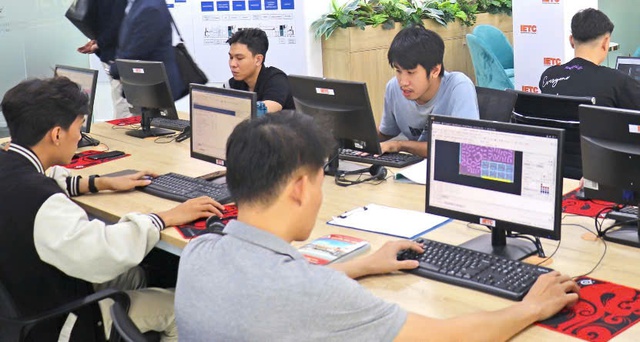The draft Project on training human resources to serve high-tech development in the period 2025 - 2035 and orientation to 2045 of the Ministry of Education and Training also aims for the proportion of people studying STEM (Science, Technology, Engineering, Mathematics) by 2030 to be 35% at each training level.
STUDENT ENROLLMENT IS MUCH LOWER THAN IN THE REGION
According to statistics from the Ministry of Education and Training, the scale and proportion of university students studying STEM fields are lower than in some countries in the region and Europe, especially the proportion of female students and especially low in science and mathematics.

The number of students studying STEM in Vietnam has increased in recent years but is still low compared to many other countries.
PHOTO: PHAM HUU
Specifically, the proportion of students studying STEM fields out of the total number of university students in recent years has fluctuated between 27 - 30%, reaching approximately 28% in 2021 (out of a total of 2.1 million students), equivalent to Israel and the average in the EU, but still much lower than some countries in the region and Europe.
For example, in 2021, this rate was 46% in Singapore, 50% in Malaysia, 35% in South Korea, 36% in Finland, and 39% in Germany. The Malaysian Minister of Science, Technology and Innovation stated that it is necessary to increase the proportion of students studying STEM to 60% to create a source of STEM talent to catalyze the country's development.
Particularly for natural sciences and mathematics, the proportion of female students is only approximately 1.5%, equal to 1/3 compared to Finland, 1/4 compared to South Korea, 1/5 compared to Singapore and Germany. Based on the total number of students enrolled in universities in 2022, the proportion of female students studying STEM fields in Vietnam is only approximately 6%, equal to 1/3 compared to Singapore, 1/2 compared to South Korea and Israel, 2/3 compared to Germany and the average of European countries.
Therefore, the Ministry of Education and Training plans to increase the scale of STEM training to over 1 million students by 2030. Of which, industries related to information technology and communications and digital technology account for about 60%.
UNDERSTANDING THE IMPORTANCE OF STEM
Explaining why the rate of students studying STEM majors nationwide is still low compared to other countries in the region, Associate Professor Dr. Nguyen Huu Hieu, Rector of the University of Technology (University of Danang), said that the most important reason is that awareness of the importance of STEM majors is still limited. Many students and parents do not fully understand the importance and career opportunities of STEM majors.
"Engineering is often considered difficult and the job after graduation is considered to be more difficult than other majors. In addition, some majors have salaries that are not commensurate, so that is also the reason why the number of students studying is not high," Associate Professor, Dr. Nguyen Huu Hieu commented.
Dr. Vo Van Tuan, Vice Principal of Van Lang University, also said that there is still a prejudice that some engineering or technology majors are difficult and boring to study. "A young person may feel that job opportunities in STEM majors are not attractive enough or are not clear enough, leading to the choice of other majors. In addition, pressure from family and society can make candidates choose safer majors instead of taking the risk of pursuing STEM majors," Dr. Tuan shared.
In addition, according to Mr. Tuan, the current general education program does not focus enough on STEM subjects, which is also the reason why students do not have enough foundation and interest in these fields.
"The learning environment at all levels still does not have much investment in STEM subjects, including teacher qualifications and facilities. According to the Government's orientation, only in recent years has STEM training been focused on and there have been initial improvements in both human resources and investment resources for facilities, but somewhere it is still not commensurate and meets the requirements of society. Because of this incompatibility, it has not created much interest for students when studying STEM subjects," Associate Professor, Dr. Hieu pointed out the next reason.

The Ministry of Education and Training plans to increase the scale of STEM training to over 1 million learners by 2030.
PHOTO: YEN NHI
INVESTMENT POLICIES ARE NEEDED TO ENCOURAGE LEARNERS
At Ho Chi Minh City University of Industry, STEM majors account for two-thirds of the total 61 training programs. The number of students studying these majors accounts for more than 50%.
Dr. Nguyen Trung Nhan, Head of the School's Training Department, informed: "In the past 2-3 years, candidates' interest in these majors has increased. This is a positive sign. To achieve the national goal of having 35% of STEM students at each training level to serve high-tech development, the government needs to have policies to attract excellent students to study such as supporting scholarships and tuition exemptions. The salary mechanism must also change. Currently, there is no specific salary mechanism for job positions in STEM majors."
Dr. Nhan also assessed that budget investment in the system of laboratories in the fields of basic science and semiconductors serving training is still weak compared to the region. "Investment costs are very expensive, up to several hundred billion VND/room, so few universities can invest on their own. Experience from other countries shows that in addition to investment from the state, businesses employing workers in these industries also have investment policies for training facilities," said Dr. Nhan.
Dr. Tran Dinh Khoi Quoc, Head of the Training Department of Da Nang University, admitted that STEM training is very expensive, not only the initial investment but also the annual maintenance costs of equipment and consumables. "However, the main difficulty is the high or low demand for recruitment at the output, which will affect the number of incoming students, thereby deciding the orientation of opening training majors of universities," Dr. Quoc commented.
To reduce the burden of investment costs, Associate Professor Dr. Nguyen Huu Hieu said that universities can build basic infrastructure, while large enterprises can contribute to laboratories and practice systems. "We can also develop online learning programs and virtual reality, simulations in STEM to reduce costs," Associate Professor Dr. Hieu suggested.


![[Photo] National Assembly Chairman Tran Thanh Man attends the summary of the organization of the Conference of the Executive Committee of the Francophone Parliamentary Union](https://vstatic.vietnam.vn/vietnam/resource/IMAGE/2025/4/15/fe022fef73d0431ab6cfc1570af598ac)
![[Photo] Prime Minister Pham Minh Chinh holds talks with Ethiopian Prime Minister Abiy Ahmed Ali](https://vstatic.vietnam.vn/vietnam/resource/IMAGE/2025/4/15/4f7ba52301694c32aac39eab11cf70a4)

![[Photo] Welcoming ceremony for Prime Minister of the Federal Democratic Republic of Ethiopia Abiy Ahmed Ali and his wife](https://vstatic.vietnam.vn/vietnam/resource/IMAGE/2025/4/15/77c08dcbe52c42e2ac01c322fe86e78b)
![[Photo] The two Prime Ministers witnessed the signing ceremony of cooperation documents between Vietnam and Ethiopia.](https://vstatic.vietnam.vn/vietnam/resource/IMAGE/2025/4/15/16e350289aec4a6ea74b93ee396ada21)
![[Photo] General Secretary To Lam receives Ethiopian Prime Minister Abiy Ahmed Ali](https://vstatic.vietnam.vn/vietnam/resource/IMAGE/2025/4/15/086fa862ad6d4c8ca337d57208555715)


























![[Photo] General Secretary To Lam meets with veteran revolutionary cadres, meritorious people, and exemplary policy families](https://vstatic.vietnam.vn/vietnam/resource/IMAGE/2025/4/15/7363ba75eb3c4a9e8241b65163176f63)





























































Comment (0)